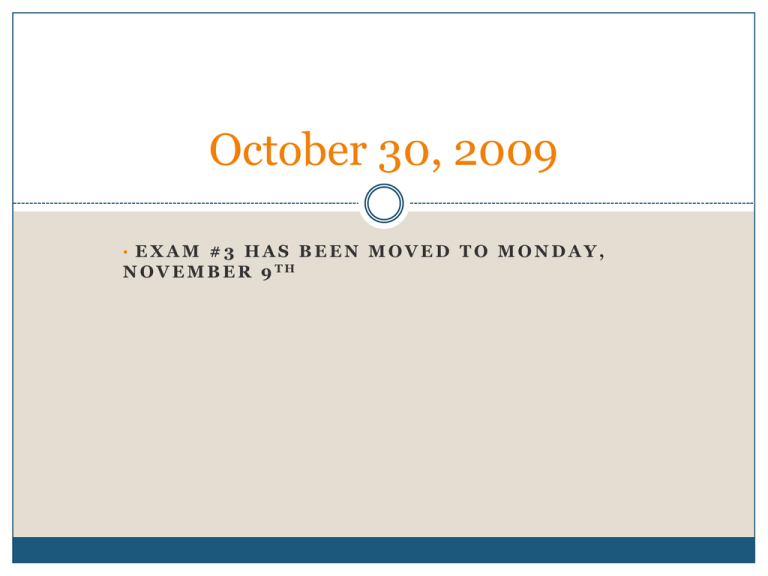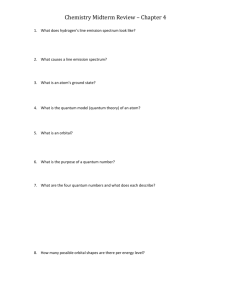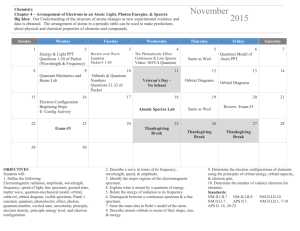Chapter 7, Part 1
advertisement

October 30, 2009 • EXAM #3 HAS BEEN MOVED TO MONDAY, N O V E M B E R 9 TH The First Three Quantum Numbers n, l, and ml are integers n = principal quantum # = 1, 2, 3, … n tells us the size/energy of the orbital l = angular momentum quantum # = 0, 1, 2, …, n-1 l tells us the shape of the orbital- s,p,d,f… ml = magnetic quantum number = –l to l ml describes the orientation of the orbital Hydrogen Nodes Orbital (n,l) Planar Spherical Total 1s (1,0) 0 0 0 2s (2,0) 0 1 1 2p (2,1) 1 0 1 3s (3,0) 0 2 2 3p (3,1) 1 1 2 3d (3,2) 2 0 2 4s (4,0) 0 3 3 4p (4,1) 1 2 3 4d (4,2) 2 1 3 4f (4,3) 3 0 3 Nodes, Revisited # of planar nodes = l # of spherical nodes = n – l – 1 Total # nodes = n–1 Example: 3d orbital What orbital has these quantum numbers? n = 3, l = 2, ml = -1 1. 4p 2. 3d 63% 3. 3p 4. 1d 5. 2f 23% 8% 4% 3% 1 2 3 4 5 What are the quantum numbers for the 5dxy orbital? 1. n = 5, l = 2, ml = 0 2. n = 5, l = -2, ml = 3 51% 3. n = 4, l = 2, ml = 2 4. n = 5, l = 3, ml = 0 5. n = 5, l = 2, ml = -5 18% 11% 1 2 11% 10% 3 4 5 Which is not a valid set of quantum numbers? 1. n = 4, l = 1, ml = -1 42% 2. n = 1, l = 0, ml = 0 41% 3. n = 6, l = 5, ml = -5 4. n = 2, l = 2, ml = 1 5. n = 3, l = 2, ml = 2 7% 8% 3% 1 2 3 4 5 The representation 5d indicates which values for n and l? 1. 2. 3. 4. n = 5; l = 0 n = 5; l = 1 n = 5; l = 2 n = 5; l = 3 77% 8% 1 10% 5% 2 3 4 What is the total number of nodes for the 5d orbital? 1. 2. 3. 4. 5. 0 1 2 3 4 57% 19% 14% 10% 0% How many spherical nodes does a 5d orbital have? 1. 2. 3. 4. 5. 0 1 2 3 4 59% 16% 12% 10% 3% 1 2 3 4 5 How many planar nodes does a 5d orbital have? 1. 2. 3. 4. 5. 0 1 2 3 4 62% 19% 12% 4% 3% 1 2 3 4 5 The Fourth Quantum Number n, l, and ml are integers n = principal quantum # = 1, 2, 3, … n tells us the size/energy of the orbital l = angular momentum quantum # = 0, 1, 2, …, n-1 l tells us the shape of the orbital- s,p,d,f… ml = magnetic quantum number = –l to l ml describes the orientation of the orbital ms is not an integer ms= spin quantum number = - ½ or ½ Electrons Spin Classical physics a spinning charge creates a magnetic field Electron spin* is quantized; the two states are called “spin up” and “spin down” *Electrons are described by quantum physics and don’t really “spin” Electron Spin is the Source of Magnetism in Materials Diamagnetic Paramagnetic Ferromagnetic (“real magnets”)









